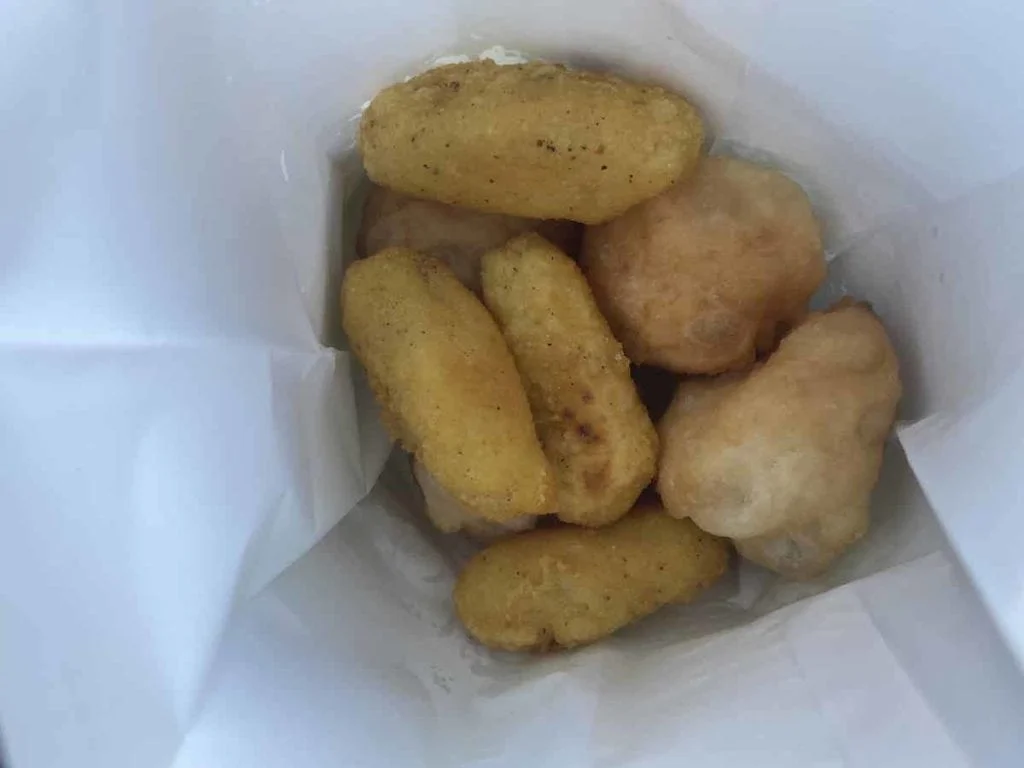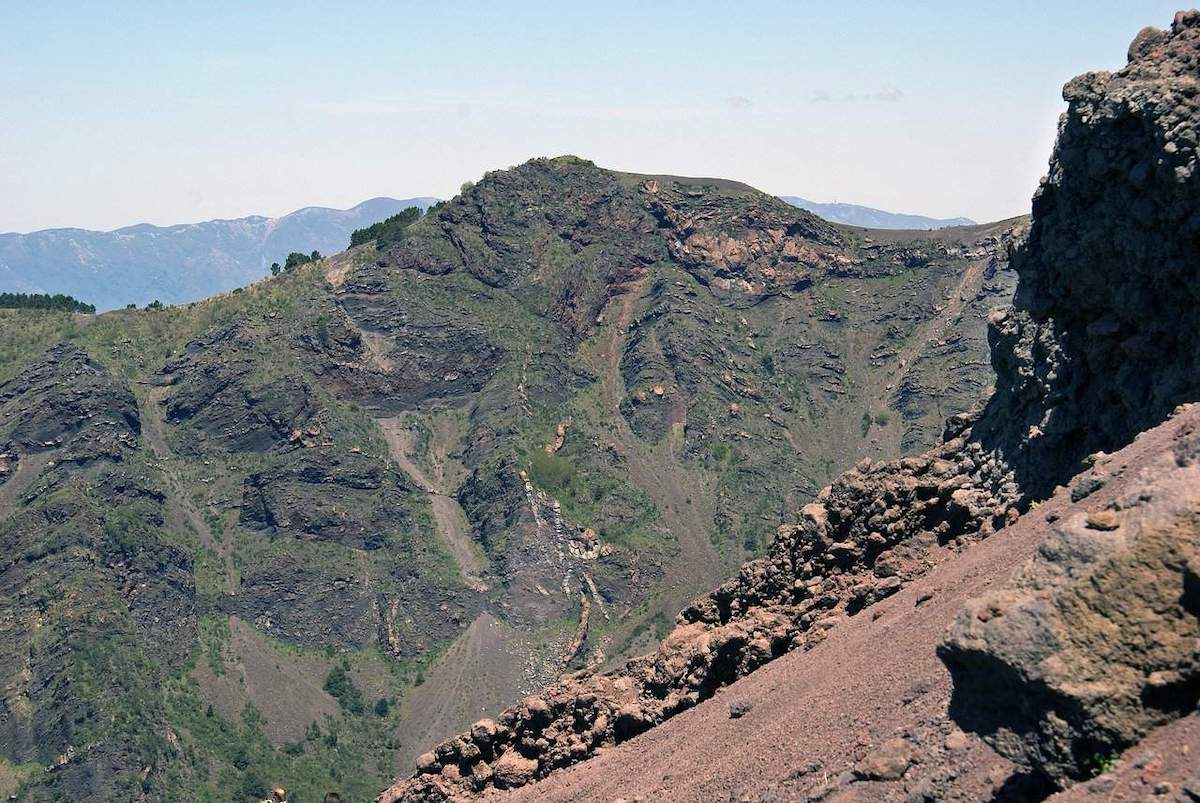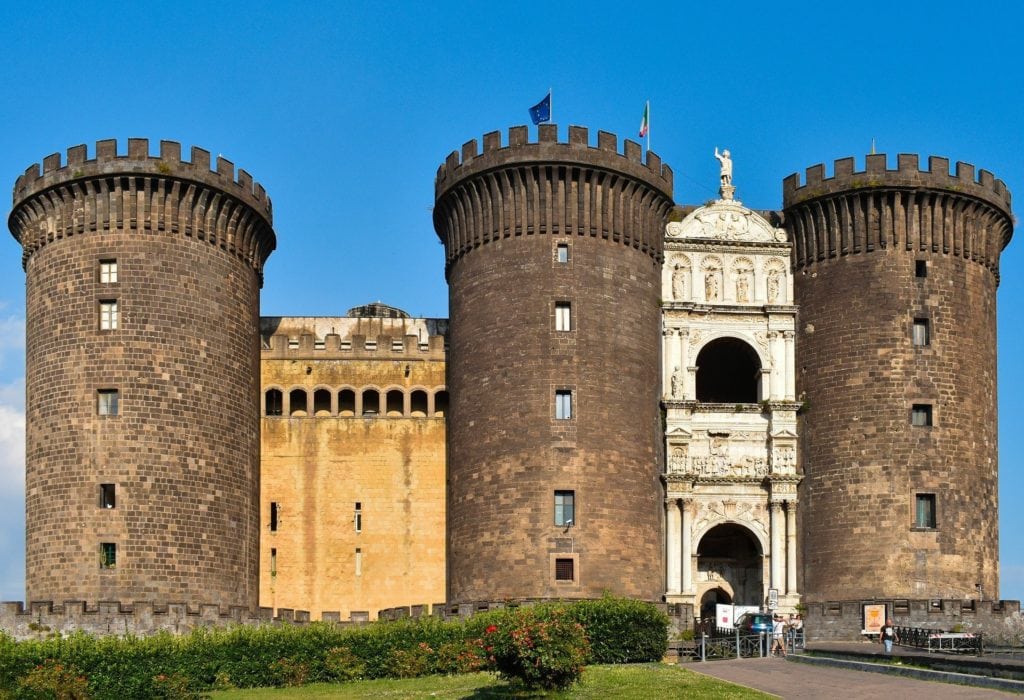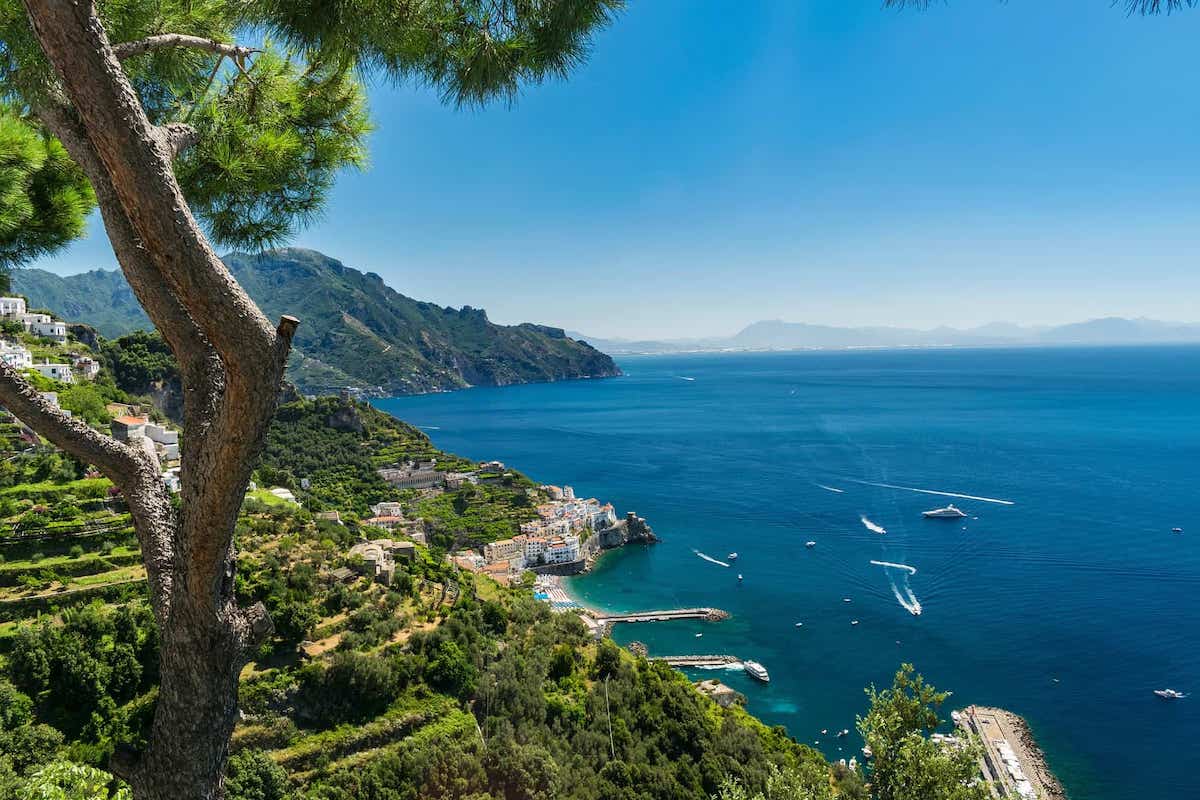This city is rich in history with its traditional buildings overlooking the glistening blue Tyrrhenian Sea.
Situated in Southern Italy in the Bay of Naples, the bustling metropolis of Naples lies in the shadow of Vesuvius.
The pale pinks and oranges of the baroque buildings, the paved piazzas surrounded by grand architecture, the tree lined streets overlooking the sea, the people calmly walking past the disorganized chaos that is traffic in Italy, all combine to create a breath-taking destination.
Table of Contents
Street Food
Anything you eat in Italy will be delicious. The food is simple, fresh and packed with flavor. Italians are so passionate about their food and the love and pride they put into creating it can be tasted. When you get home, you’ll be searching for recipes to try to recreate the taste as you pine for the Neapolitan food.
Street food is popular in the Bay of Naples; however, it’s not actually sold on the street.
It can be found throughout the city and the smell and sight of the rows of treats in the window will have you salivating. Created by the poor to be eaten on the street and for a reasonable price. One of my personal favorite - introduced to me by my husband - is La Padella, their food is insane, you must try it when in Napoli.

Favorites of the locals are pizza a portafoglio or folded pizza, il cuoppo (a paper cone filled with fried food, such as fish or mozzarella), or if you have a sweet tooth, the traditional dessert, Babà al Rhum. This moist sponge cake is shaped like a cork, soaked in rum with cream or Nutella inside; the mere sight of one would make your mouth water.

And don’t forget to stop in for a coffee. Stand at the counter like a local with your espresso. A glass of water comes with your coffee which you drink before. Frothy coffees like cappuccino’s and lattes are only served in the morning, if you’re being authentic. The rich aroma of the coffee wafting out onto the street is enough to entice anyone in.
Italy can be expensive so street food can be a great option to eat cheap while on the go. Or grab it and sit in one of the piazzas to people watch. If you are eating in, be aware of touristy places as the prices may increase. Restaurants with pictures of the food on the menu are a giveaway that the establishment is for tourists. If the waiter sets water or bread on your table, make sure it is free before tucking in as it will be
added to your bill.
Shopping
There is a huge variety of shopping in Naples. From designer clothing, vintage items and boutiques to souvenirs.
Not only is the shopping an attraction but the shops themselves are some of the most impressive buildings.
Via Toledo is a 12-kilometer-long street which connects the Piazza Dante to Piazza Trieste e Trento. There is a variety of retailers from big chains to boutiques and designers, such as Bulgari and Gucci. The Galleria Umberto I is situated in this street, an ornately decorated building with a glass dome roof. The rows upon rows of windows with golden pillars and marble is worth a look even without buying anything.
The Chiaia district connects to the piazzas and includes luxury and exclusive shops. You may only be able to window shop here, strolling past the attractive window displays.
The Poggioreale Market is famous for its leather goods with more than 500 shops to choose from. A'Curreia is another place to find leather goods, along with designer retailers and boutiques.
If your budget doesn’t stretch to designer gear, Oblomova is packed with vintage items, including records.
The Antignano Market is located in the Vomero Hill area, an area with more reasonably priced items. A mix of handmade products, local produce, boutiques and department stores are a popular shopping destination.
The San Gregorio Armeno Market is particularly popular at Christmas with their nativity display and traditional Christmas food and steaming hot chocolate. This paved alleyway is packed with products outside the shop fronts, from antiques to crafts and books.
The architecture at Galleria Principe Di Napoli is as much an attraction as the shopping. A huge arch like the Arc de Triumph acts as the entrance, as you walk in, a glass arching roof lets in the light.
The best place for cheap bits and pieces is Resina Market. It is a historic market with all sorts of items, including clothes and homeware.
Vesuvius
No trip to this region is complete without at least glimpsing from afar, the famous volcano that is Vesuvius. Vesuvius rises 1,281 meters above the Bay of Naples, casting a shadow over the 3 million people in the towns below.
Vesuvius is one of the two active volcanoes in Europe - the other one is Etna in Sicily.
It is famous for destroying the cities of Pompeii and Herculaneum in 79AD. The last eruption was in 1944 and some scientists have predicted it is due for another eruption any year now, perhaps being so extreme, it could take out most of the Bay of Naples.
The andesite lava that is spewed from the volcano creates explosive eruptions which makes it particularly dangerous and unpredictable. One of the world’s most dangerous volcanos.
Archeologists have found footprints as victims fled from previous eruptions. Their footprints centuries later showing the devastation and horror that the volcano can unleash.

Today it is possible to walk to the rim of the crater and look into the depths below. Day trips are available, and a bus will take you to an upper car park. Make sure to purchase tickets beforehand to avoid any scams, as can be common at any tourist attraction. From there it is a steep enough walk, around twenty minutes, towards the crater. The smell of Sulphur swirling in the air and the puffs of smoke emitting from below its surface. Only sparse tufts of greenery reach the top of the crater, most of the area still bare from previous eruptions.
The view from the crater is breath-taking. The greenery blanketed at the bottom until smatterings of buildings become towns, packed tightly together until the glistening blue sea. A mist hangs overhead and the air is colder at this altitude.
Minor earthquakes continue in the region, the most serious in 1999 which was felt 15 miles away. However, it is still safe to visit this intimidating natural formation.
Pompeii
A holiday resort for the wealthy in 8 th century B.C., this roman town was a sophisticated, thriving place. Unbeknown to the inhabitants their town lay under threat from a volcano. Thick with greenery, the volcano appeared to be like any other mountain, five miles from their town.
In 79AD, the volcano awoke, sending a pillar of ash, pumice and gases soaring into the sky. Rising miles high and spreading out like the branches of a tree, shrouding the sky in darkness, turning day to night. Most of the 12,000 inhabitants fled but those who did not struggled to breathe in the thick air. Poisonous gas and pulverized rock surged down the mountain at 100 miles per hour, burying the town.
This violent eruption killed as many as 16,000 with more being discovered as late as 2016.
The city of Pompeii and Herculaneum were buried and forgotten for centuries.
While digging in the area centuries later, the town was uncovered by accident. Archaeologists were astounded to find the town, and not only that, but that it was perfectly preserved by the ash. The cobbled streets, the frescos painted on the walls,
the brothels, the baths, the amphitheater and most fascinating, the bodies of victims encased in ash. There were bodies curled up, clutching their knees, lying beside each other in their last moments and even a dog, preserved at their moment of death. Frozen in time and uncovered years in the future, here were examples of the
horrors of the eruption.
This UNESCO Heritage Site is well worth a visit and the guided tours can give an insight into how the inhabitants lived. A whole day could be spent strolling the cobbled streets, admiring the frescos, the reds, blues and yellows still bright upon the walls. There are several graphic images depicted in the brothel so beware if travelling with under eighteens.

Some of the victims are kept in glass cases and some lie as they did all those centuries ago, huddled on the ground.
The amphitheater here is the oldest roman amphitheater in the world. The rows upon
rows of seats curved round the vast space in the middle where plays or battles would have taken place.
There is little shade from the scorching sun, which can reach over 80 Fahrenheit, so visiting either early or late in the day is recommended. The water taps, which are a feature all over Italy, can be used to fill your bottle with fresh, cold water. The stalls outside are swamped with lemons and offer fresh lemonade to tourists.
The city of Herculaneum, which was also buried beneath the ash, can be visited and is quieter but it would be a rush to visit both on the same day.
Pompei is easily accessible by train from Napoli Centrale station, it's a 40 mins direct journey for a few Euros.
Marina di Varcaturo
The Marina di Varcaturo is a stretch of beaches along the coast, forty minutes from Naples. There are many hotels and restaurants and a thriving nightlife. It is a tourist spot - filled with mainly Italians - so if you are more interested in a more authentic experience, this won’t be were you find it. However, it is a perfect place to relax, I love its many "lidos" like Ammot Cafe, Lido Varca d'Oro and Scilla Cafe. (If you're also after a lovely hotel nearby, definitely book at Hotel Bellavista, it's a super clean, family run hotel with amazing staff, reasonable prices, pool and free parking.)
The huge expanse of beach is dotted with palm trees and overlooks the sparkling blue sea.
Hills rise at the end of the bay, covered in luscious greenery. The yellow umbrellas sprawl across the beach as tourists relax on the sun loungers underneath, the sound of the sea lapping at the sand lulling you into a trance. Have a bite to eat in the restaurants overlooking the sea or wait until darkness falls to revel in the lively music.
Naples
Naples is the third largest city in Italy and is steeped in history from ancient Grecian times to the Roman Empire. Packed with historical buildings, piazzas and amazing views over the Bay of Naples, it is hard to choose the best things to do in Naples.
Visit the San Gennaro Catacombs.
Beneath Naples lies an underground world; the San Gennaro Catacombs. There are two levels; on the lower floor there are over 3000 burials that may give you chills as you walk the narrow passages. The upper level contains artwork, an aqueduct, raid shelters from the second world war, and the remains of a roman theatre where
Emperor Nero had his own dressing room before he performed shows.
Two castles feature on Naples landscape. Castel Nuovo, built in 1282, is immaculately preserved. The intimidating round towers with battlements and front archway, inset with statues. Castel dell‘Ovo is a fortress carved as if from the rock itself, risen from the sea.

The royal palace is located in the Piazza del Plebiscito, both worth a visit. The huge area bustles with people over its cobbled square. The Royal Palace dominates the piazza with its huge domed building and rows of pillars taking up one side of the piazza.
The many churches and cathedrals dotted around Naples are worth stopping by. Ornately decorated, and peaceful inside, each one unique in its own way.
Day Trips from Naples
There are so many things to do in Naples, but it is situated close to a lot of other highlights in Southern Italy which make it a great base to explore the surrounding area.
The Amalfi coast is one of the most beautiful landscapes; colorful houses stacked one after another on the side of the hills, thick greenery, the azure sea and golden domes of churches glinting in the sunlight.

Each sleepy village, one after another along the coast, interspersed with groves of olive trees or lemon trees, hanging bright yellow and sending a citrus fragrance through the air.
Popular destinations are Sorrento, Positano (a celebrity spot), or the islands of Capri, Ischia with its thermal spas, Procida with its cobblestone streets, or Corricella which featured in The Talented Mr. Ripley.
Naples is a city rich in culture in the most mesmerizing location and is an ideal location for exploring many places in Southern Italy. Whether it’s the bustle of lively streets, the food, the beaches, or the activities which catch your attention, the city is sure to exceed high expectations.
To read more articles about cities, check out my other blog posts.